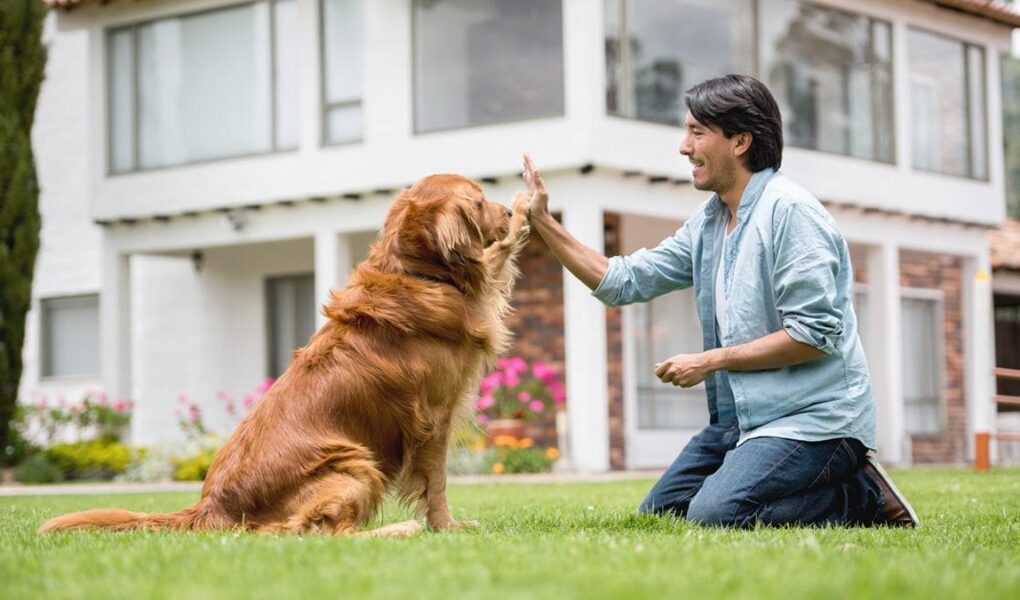Title: The Golden Path to a Well-Trained Companion: Unlocking the Secrets of Golden Retriever Training
Introduction:
As the sun rises over a dew-kissed backyard, the joyful barks of Golden Retrievers fill the air, their golden coats gleaming in the soft morning light. Renowned for their unwavering loyalty, intelligence, and playful spirit, these furry companions have won the hearts of families around the world. However, the journey to a well-behaved Golden Retriever is not just paved with treats and affection; it requires dedication, patience, and a sprinkle of creativity. In this article, we will explore the essential techniques and strategies for training Golden Retrievers, unraveling the unique intricacies of their behavior while ensuring that the process is as enjoyable for the dog as it is for the owner. Whether you’re a seasoned trainer or a first-time dog parent, prepare to discover the golden keys to fostering a harmonious relationship with your beloved companion.
Table of Contents
- Essentials of Effective Golden Retriever Training Techniques
- Building a Foundation of Trust and Communication
- Engaging Activities for Mental Stimulation and Physical Health
- Overcoming Common Training Challenges with Patience and Consistency
- Q&A
- To Wrap It Up
Essentials of Effective Golden Retriever Training Techniques
When it comes to training your golden retriever, establishing a strong foundation of basic commands is essential. Begin with simple commands such as ”sit,” “stay,” and “come.” By using positive reinforcement techniques, like treats and praise, your dog will quickly associate these commands with rewards. Consistency is key, so practice these commands regularly in various environments to enhance your dog’s ability to focus amid distractions. As your dog’s confidence grows, gradually introduce more advanced commands, ensuring that each new skill is built on your trusty foundational techniques.
Another critical aspect of effective training involves understanding the unique temperament of golden retrievers. This breed is known for its eagerness to please and high intelligence, making them highly trainable. To capitalize on these traits, engage in activities that tap into their natural instincts. Incorporate fetch games which nurture their retrieving skills while reinforcing bonding time. Establish a structured routine that includes exercise, mental stimulation, and training sessions to keep your golden engaged. Remember, a well-rounded training approach ensures a happy, obedient dog who thrives in both social and home settings.
Building a Foundation of Trust and Communication
Establishing a purposeful connection with your golden retriever is essential for successful training. These lovable companions thrive on positive interactions that foster a sense of security and cooperation. A solid foundation hinges on the following elements:
- Consistency: Use the same commands and cues each time to avoid confusion.
- Patience: Remember that learning takes time; celebrate small victories.
- Positive Reinforcement: Reward desired behaviors with treats, praise, or play.
- Body Language: Be aware of your non-verbal signals; dogs are adept at reading our emotions.
Effective communication lays the groundwork for a healthy relationship. By engaging with your golden retriever through clear verbal signals and encouraging gestures, you ignite their natural eagerness to learn. Consider implementing a structured training routine reflected in this simple schedule:
| Day | Activity | Duration |
|---|---|---|
| Monday | Basic Commands | 15 minutes |
| Wednesday | Leash Training | 20 minutes |
| Friday | Interactive Play | 30 minutes |
This structured approach not only reinforces skills but also enriches your dog’s overall experience. Trust and communication will shine through as you train, creating a bond that transcends mere obedience.
Engaging Activities for Mental Stimulation and Physical Health
Training a golden retriever is not just a way to teach them commands; it’s an excellent opportunity for mental engagement and physical exercise. By incorporating fun activities into their training routine, you provide your pup with a stimulating environment that enhances their cognitive abilities while promoting their physical health. Here are a few engaging activities to consider:
- Obstacle Course: Create a DIY obstacle course using items around your home. Use cones, tunnels, and jumps to keep their minds sharp while they navigate the course.
- Hide and Seek: This game can sharpen their problem-solving skills. Hide somewhere in your house or yard and call your dog to find you. Reward them with treats!
- Interactive Toys: Use puzzle toys that dispense treats when they solve the challenge. This keeps their mind busy and reduces boredom.
- Fetch with a Twist: Instead of just throwing a ball, throw it in different directions to challenge their tracking abilities and stamina.
Understanding the right mix of physical exercise and mental stimulation is essential for your golden retriever’s well-being. Consider establishing a weekly schedule that balances these activities effectively. Here’s a simple table to help plan out the week:
| Day | Activity | Duration |
|---|---|---|
| Monday | Obstacle Course | 30 mins |
| Wednesday | Hide and Seek | 20 mins |
| Friday | Interactive Toys | 15 mins |
| Saturday | Fetch | 40 mins |
Overcoming Common Training Challenges with Patience and Consistency
Training a golden retriever can sometimes feel like an uphill battle, especially when faced with common setbacks. However, embracing a mindset grounded in patience and consistency can dramatically enhance the training experience. When your pup struggles to grasp a command or gets distracted, remind yourself that progress takes time. Celebrate the small victories along the way, whether it’s a successful sit or a well-timed recall. Recognizing and addressing each training challenge with a positive attitude not only fosters a stronger bond with your furry friend but also creates an enjoyable learning environment.
Establishing a structured training routine is crucial for overcoming obstacles. Consistency in approach allows your golden retriever to understand what is expected of them. Here are some effective strategies to incorporate into your training routine:
- Set Specific Goals: Focus on one command or behavior at a time.
- Use Positive Reinforcement: Reward your dog with treats, praise, or playtime.
- Keep Sessions Short: Limit training sessions to 5-10 minutes to maintain your dog’s interest.
- Practice Regularly: Train daily to reinforce learning and build routines.
Overcoming these training challenges does not require a one-size-fits-all solution; instead, it’s about finding what works best for you and your dog. Consider keeping track of your training progress with a simple table:
| Training Session | Focus Command | Duration | Outcome |
|---|---|---|---|
| 1 | Sit | 10 mins | Success |
| 2 | Stay | 5 mins | Moderate |
| 3 | Come | 7 mins | Improving |
Q&A
Q&A: Mastering the Art of Golden Retriever Training
Q1: Why is training important for a golden retriever?
A1: Training is essential for golden retrievers because it not only fosters good behavior but also strengthens the bond between you and your furry friend. These intelligent and eager-to-please dogs thrive on learning new commands and skills, which provides them with mental stimulation. A well-trained golden retriever is happier, more confident, and better equipped to navigate the world around them.
Q2: At what age should I start training my golden retriever?
A2: The earlier, the better! You can start training golden retriever puppies as young as seven weeks old. Early socialization and basic commands like sit, stay, and come lay the groundwork for more advanced training. However, older dogs can still learn new tricks—it’s never too late to start this rewarding journey.
Q3: What are some effective training techniques for golden retrievers?
A3: Positive reinforcement is the gold standard for training golden retrievers. Rewarding your pup with treats, praise, or playtime when they follow commands encourages them to repeat the behavior. Other techniques include consistency in commands and schedules, short but frequent training sessions (around 5-10 minutes), and introducing variations to keep things interesting.
Q4: How can I address common behavioral issues in my golden retriever?
A4: Common behavioral issues, such as jumping, chewing, or excessive barking, can be tackled through consistent training and redirection. For instance, if your golden tends to jump, teach them an alternative behavior, like sitting when greeting people. Regular exercise also plays a key role in curbing destructive behaviors—an unexercised golden is often an unruly one!
Q5: Can I train my golden retriever myself, or should I hire a professional?
A5: Many golden retriever owners successfully train their dogs using resources like books, online videos, or classes. That said, hiring a professional trainer can be beneficial, especially if you’re facing specific challenges or if your dog isn’t responding as you’d hoped. A trainer’s expertise can provide you with personalized techniques and support tailored to your dog’s needs.
Q6: How do I keep training sessions fun and engaging for my golden retriever?
A6: Variety is key to maintaining your dog’s excitement about training. Incorporate games like fetch with command reinforcement, change locations for training sessions, or use puzzle toys to stimulate their minds. Always end sessions on a positive note with a fun activity or a favorite treat, so your golden associates training time with happiness.
Q7: What should I do if my golden retriever is not responding to commands?
A7: If your golden retriever seems unresponsive, consider if there are distractions in the environment or if you’re inadvertently communicating instructions unclearly. Be patient and revisit the basics. Break down commands into smaller steps if necessary, and consult resources or a trainer if the lack of response persists—sometimes, a fresh perspective can make all the difference.
Q8: Is there any specific breed trait that influences the training of golden retrievers?
A8: Absolutely! Golden retrievers are known for their friendly disposition, intelligence, and eagerness to please. These traits often make training more accessible compared to other breeds. However, it’s essential to recognize that each dog is unique, and their individual personality will influence how they learn and respond. Patience, empathy, and adaptability are crucial to harmonious training.
Q9: How can I ensure socialization alongside training?
A9: Socialization should be woven into your training regimen. Expose your golden retriever to different environments, people, and other animals in controlled settings. Puppy classes are fantastic opportunities for socialization and learning simultaneously. Remember, balanced training incorporates both commands and the ability to behave well in diverse social situations.
Q10: What’s your best tip for new golden retriever owners embarking on training?
A10: Enjoy the process! Training is not just about teaching commands; it’s about deepening your relationship with your golden retriever. Celebrate the small victories, stay patient during setbacks, and create joyous memories together. After all, the journey of training is as priceless as the paw prints they leave on your heart.
To Wrap It Up
training your golden retriever is not just about teaching obedience; it’s an enriching journey that strengthens the bond between you and your furry companion. Through patience, consistency, and positive reinforcement, you can help your golden unlock their full potential, transforming them into a well-mannered member of your family. Remember, each wagging tail and joyful bark is a sign of progress, so celebrate the small victories along the way. Whether you’re teaching basic commands or embarking on advanced tricks, the time you invest in your golden retriever today will pay off in countless moments of joy and companionship tomorrow. Embrace the process, and enjoy every playful paw-step of the way!



